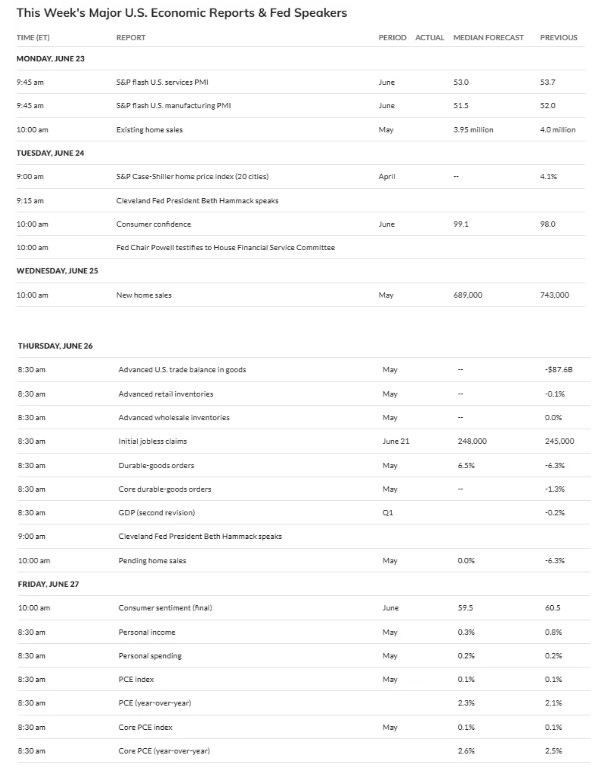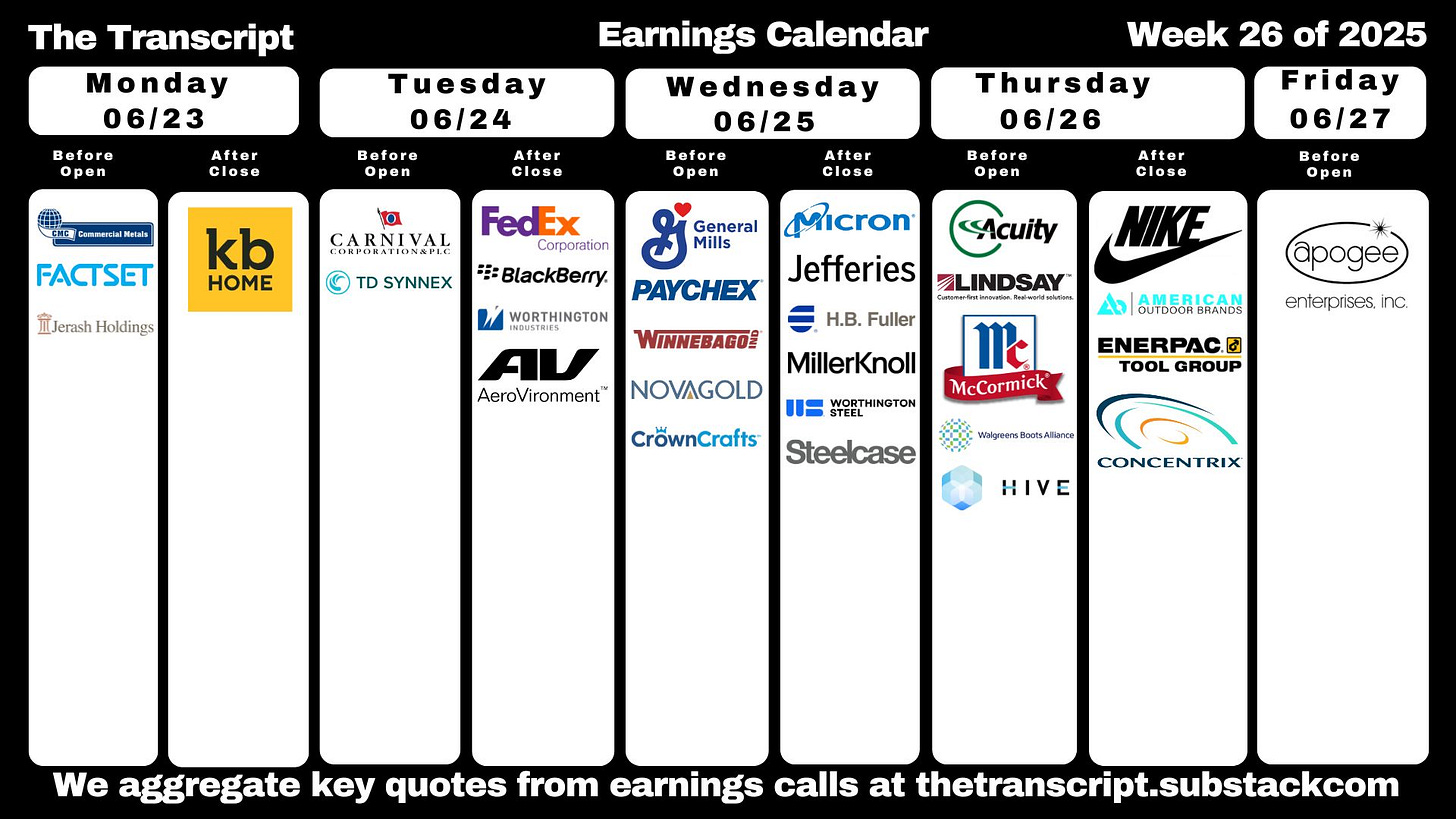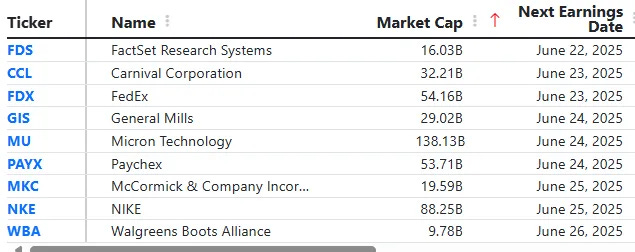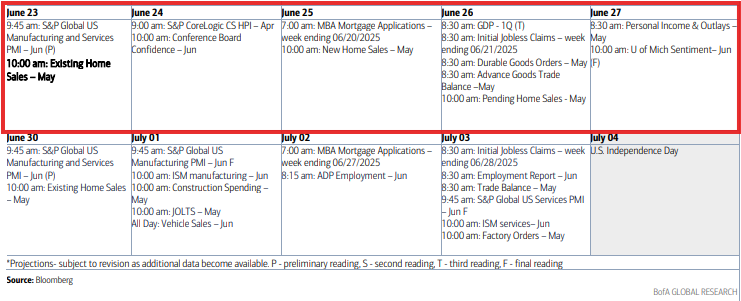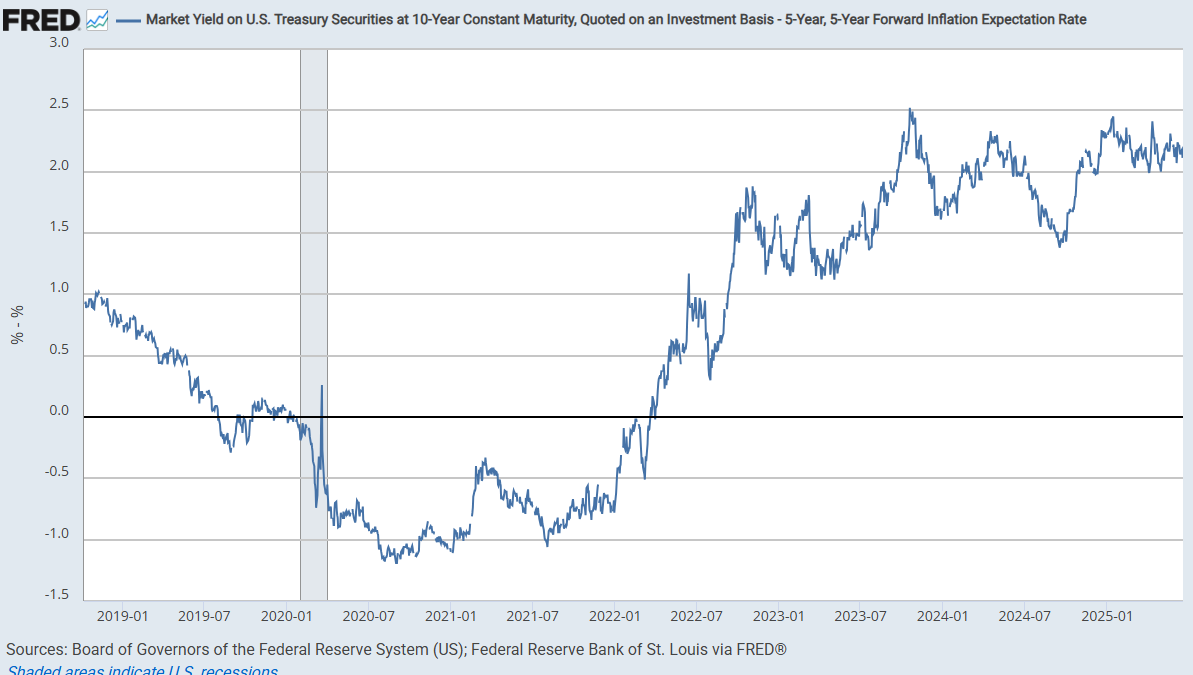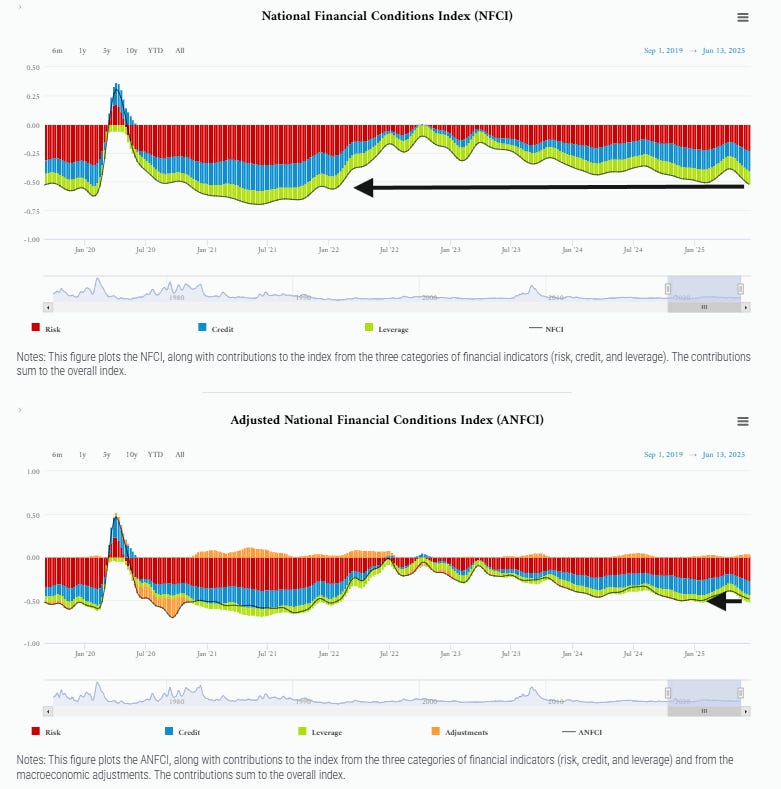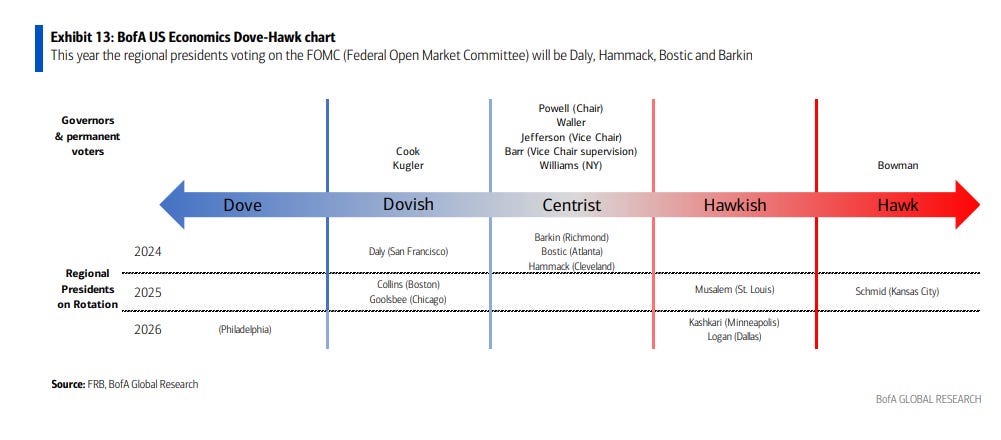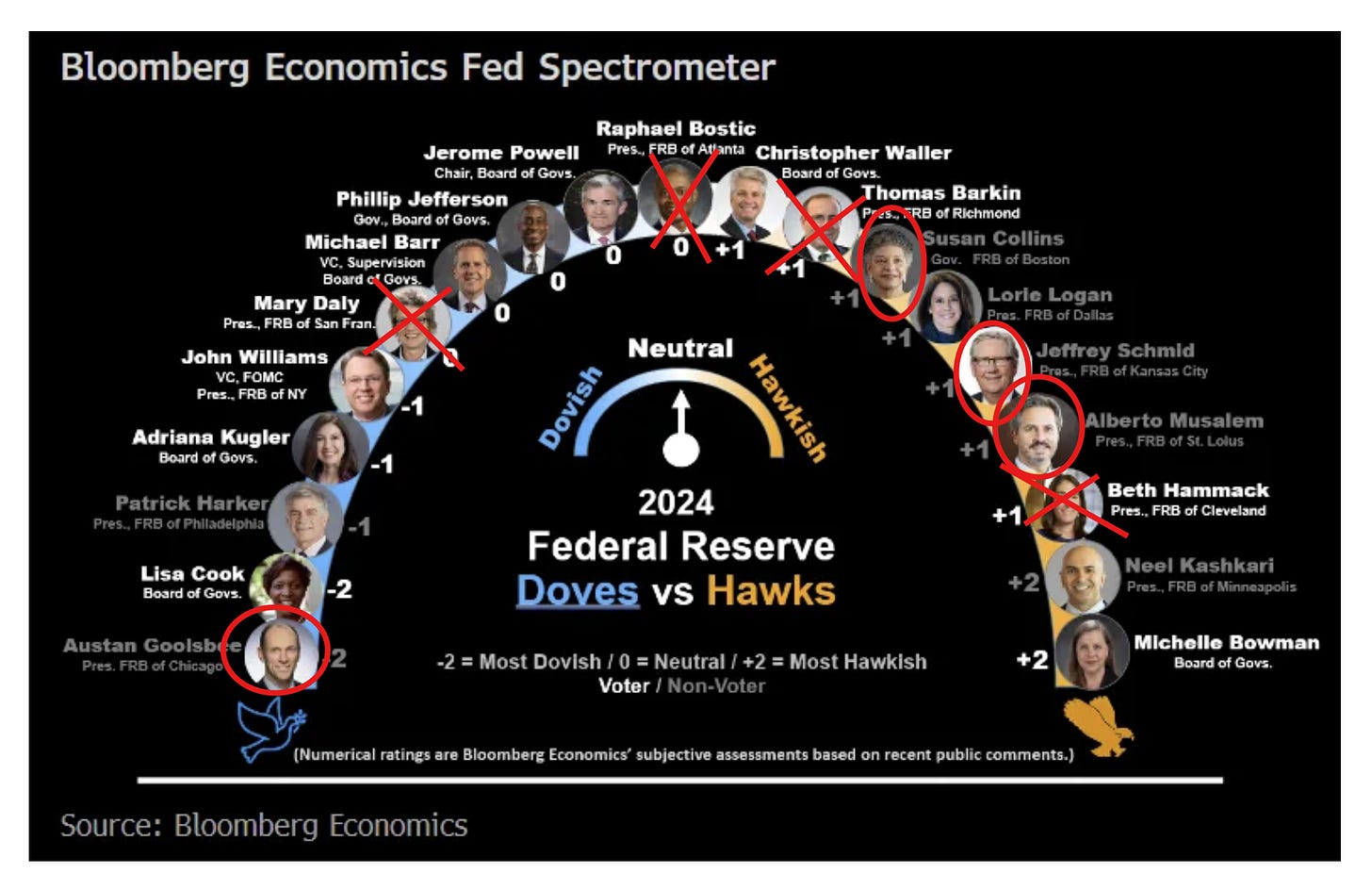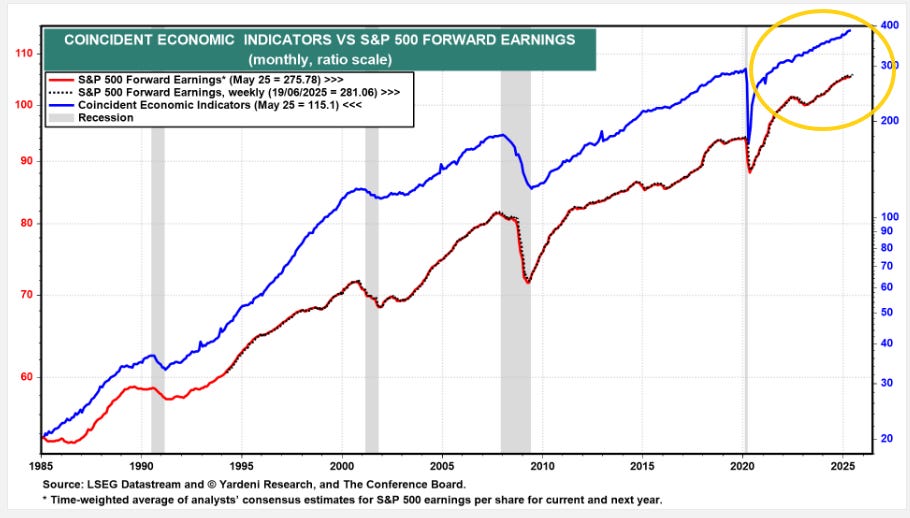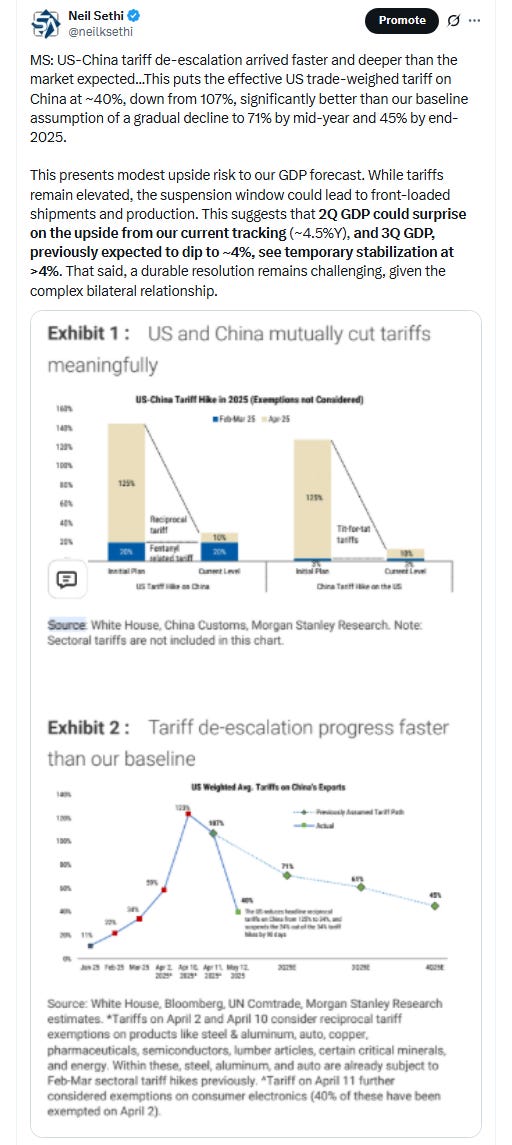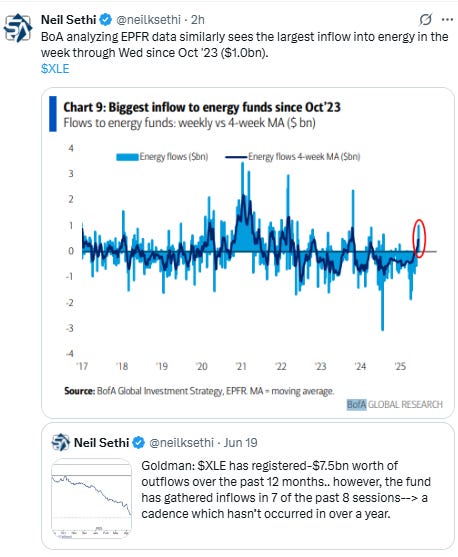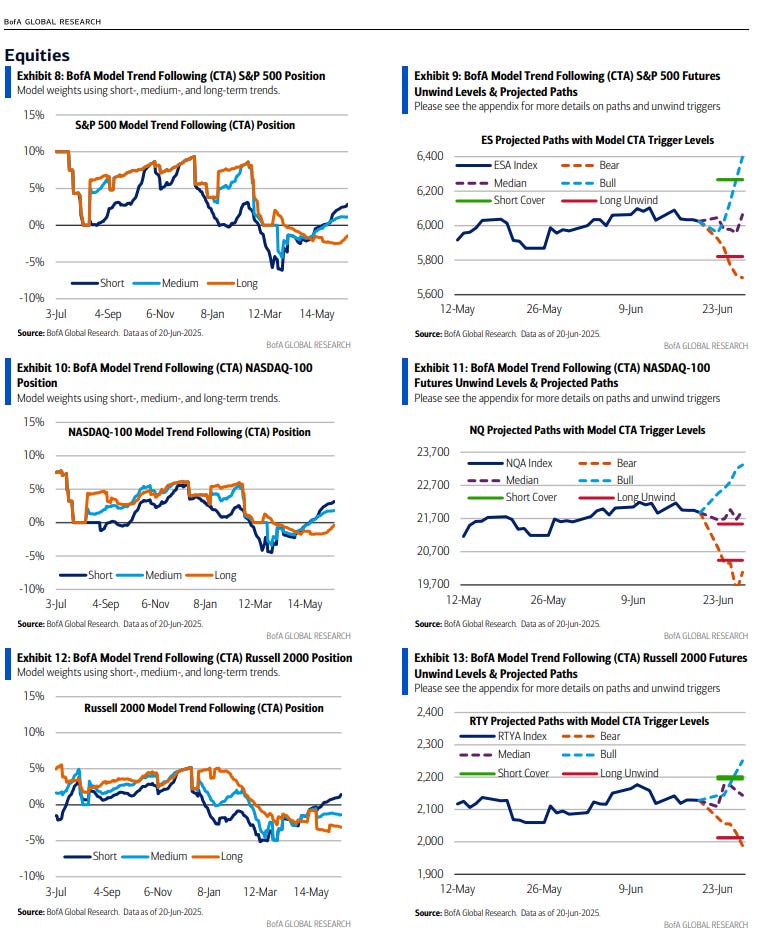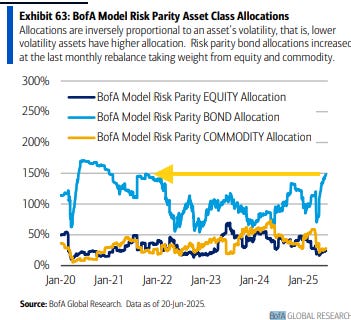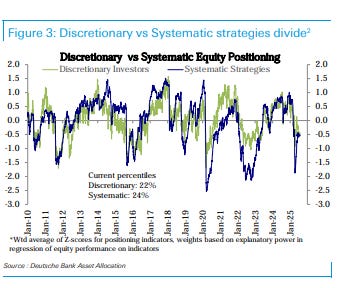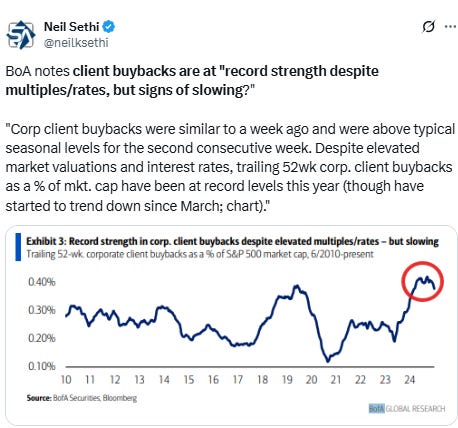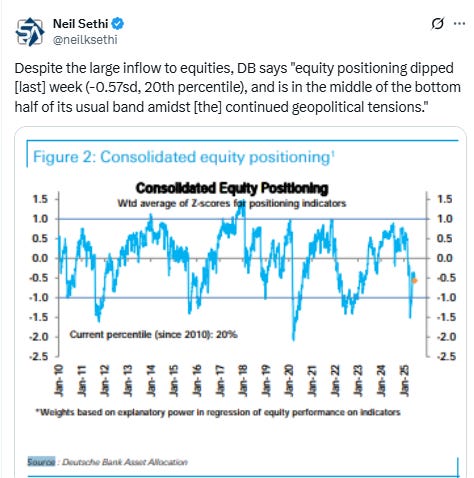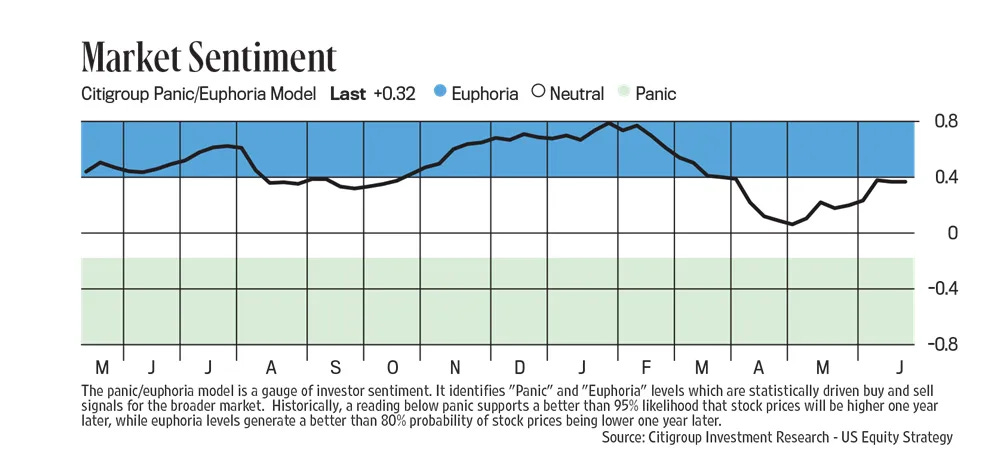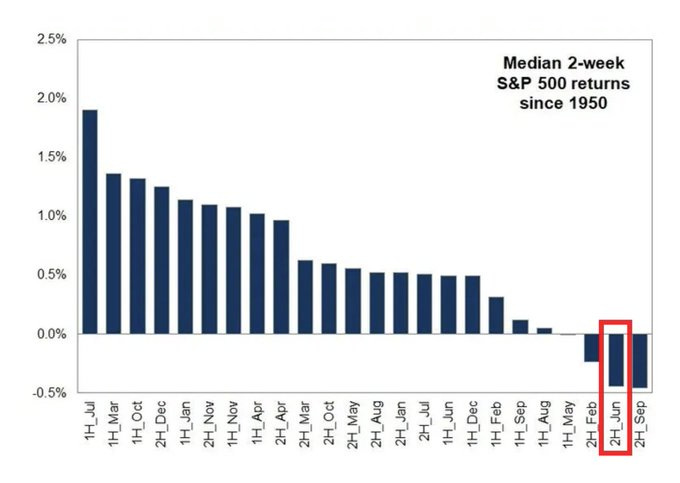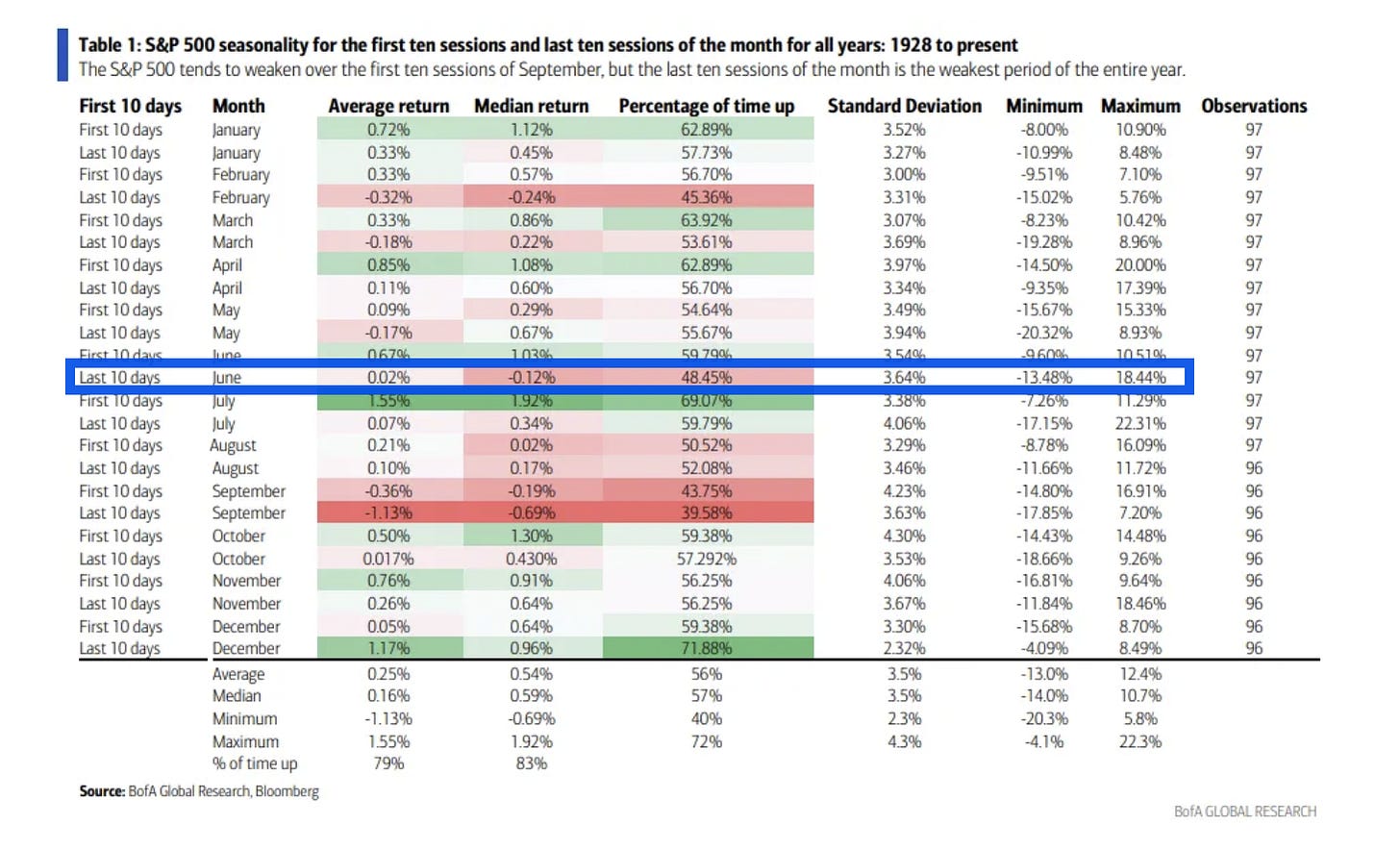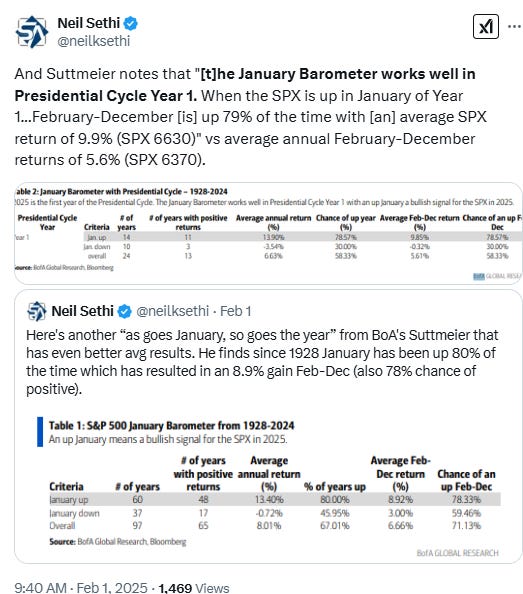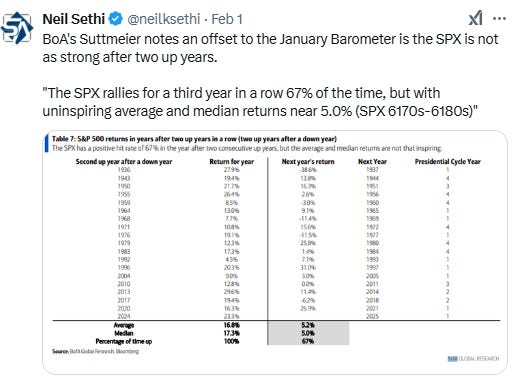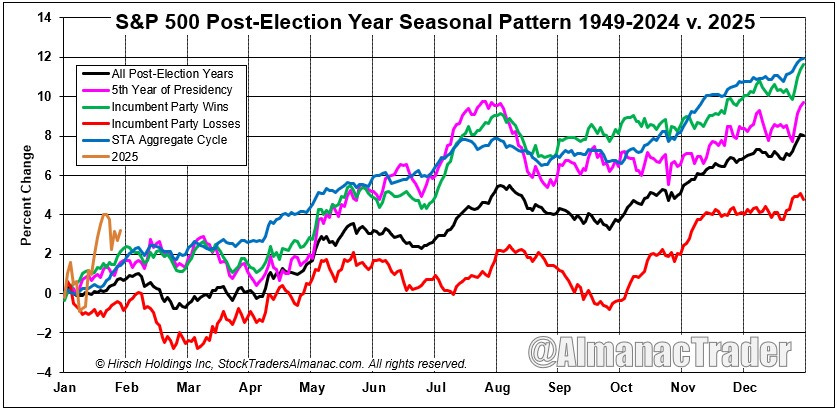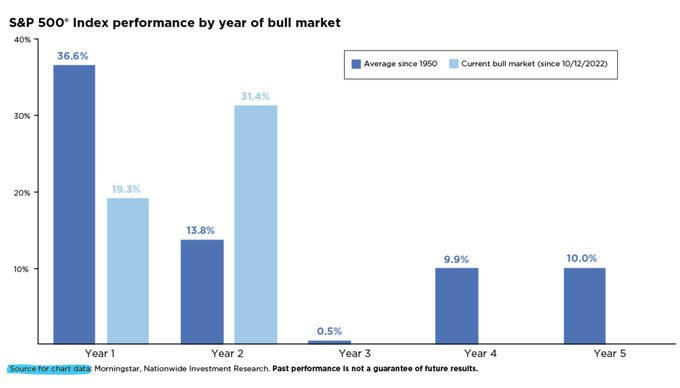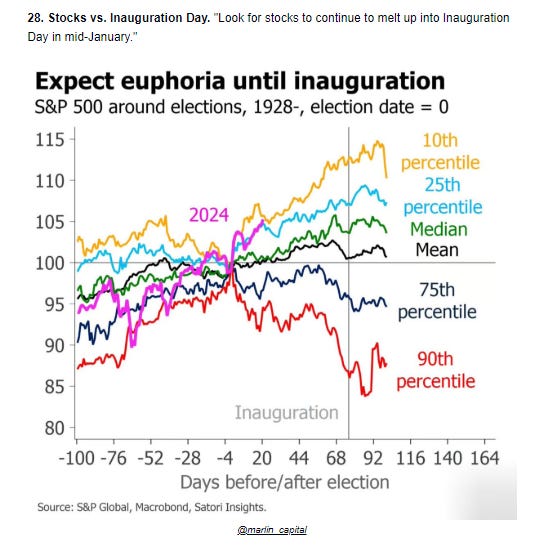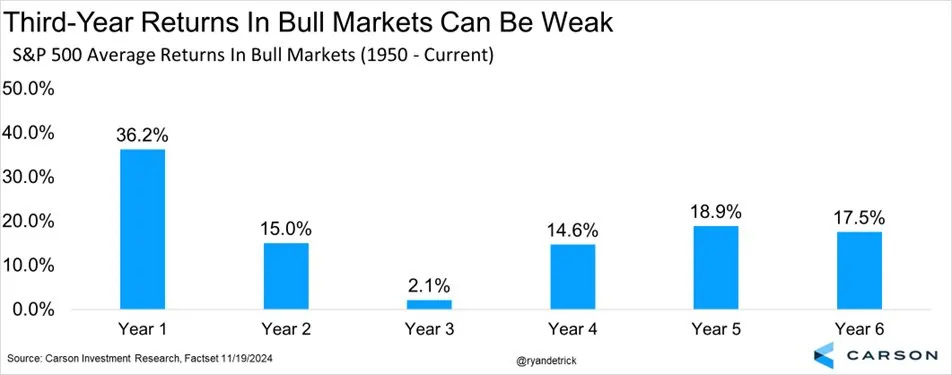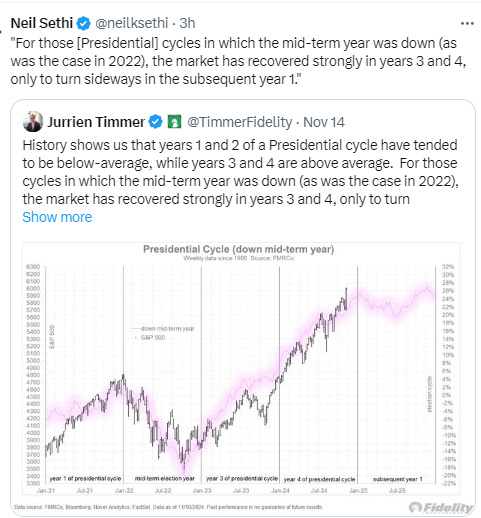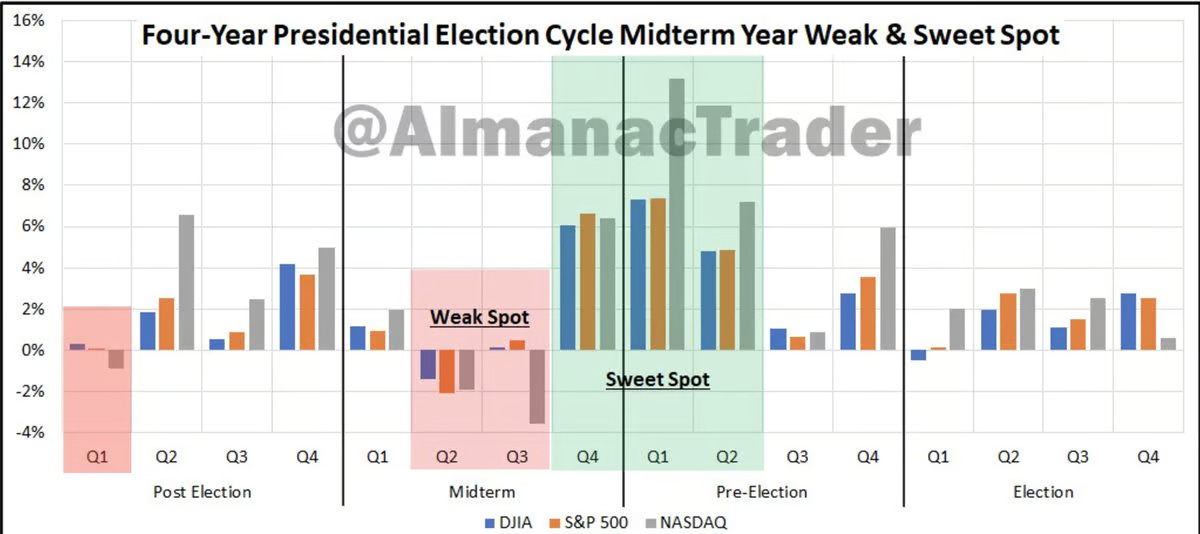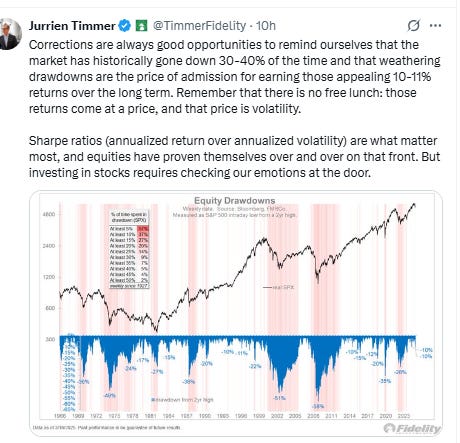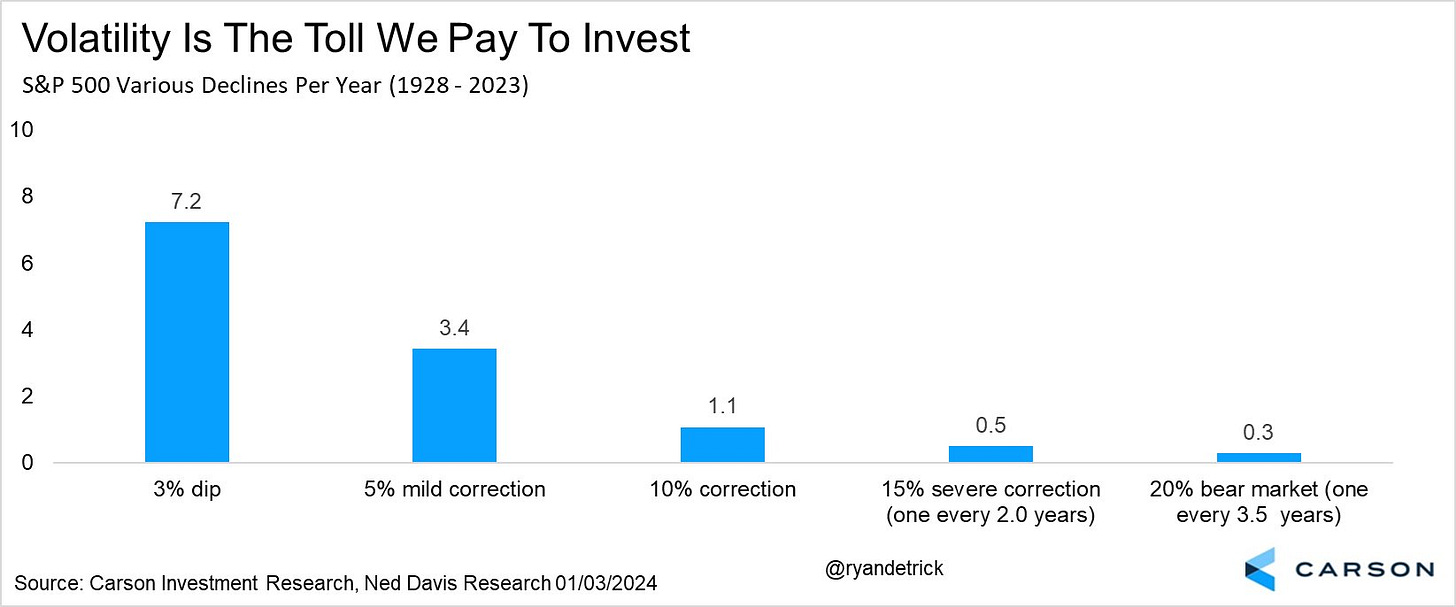The Week Ahead - 6/22/25
A comprehensive look at the upcoming week for US economics, equities and fixed income
If you're a new reader or maybe one who doesn’t make it to the end feel free to take a second to subscribe now. It’s free!
Or please take a moment to invite others who might be interested to check it out.
Also please note that I do often add to or tweak items after first publishing, so it’s always safest to read it from the website where it will have any updates.
As a reminder, I leave passages in from prior weeks for reference purposes, because it’s in-between updates, it provides background information, etc.. Anything not updated this week is in italics. As always apologize for typos, errors, etc., as there’s a lot here, and I don’t really have time to do a thorough double-check.
For new subscribers, this is a relatively long post. The intent is to cover the same areas each week. Sometimes the various areas are more interesting, sometimes less, but it’s easier just to go through them all, so you can expect this format (with things in the same places) each week.
The main sections are intended to cover 1) what’s upcoming next week, 2) what the Fed and rates are up to, 3) what’s going on with earnings (which along with valuations are the most important determinants to stock prices over the long term), 4) what’s going on with the economy (both because of its impact on our daily lives (I am a business investor in my “real” job) but also because it impacts earnings), 5) valuations, 6) breadth (which gets into sector/style performance), 7) positioning/flows (this is the most important determinant to asset price changes in the short term), 8) sentiment (really only matters at extremes though), 9) seasonality (gives you an idea of what normally happens), 10) “Final Thoughts” (remember you get what you pay for there, and it’s the last thing I do so it often is a bit rushed), and 11) my portfolio (to be transparent about where my money is in the market (but note first it is most definitely not intended as financial advice, and second as I mentioned earlier my main job (and investing assets) are in private industries (RE & venture capital)) so my portfolio is built with that in mind (i.e., it’s not how I pay the day-to-day bills)).
The Week Ahead
A busy week is on tap starting with the fallout of the US attack on Iran, but also with lots of US economic data, a return to Fedspeak including the Chair appearing for two days in front of Congress, NATO kicking off a three-day summit at the Hague, earnings from FedEx, Micron, and Nike among others, and plenty going on in Washington beyond the Iran situation as we’re coming up on the July 9th deadline for decisions on reciprocal tariffs, and the July 4th soft deadline for passage of the Big Beautiful Bill.
Looking at US economic data for the upcoming week, it’s a typical last-week-of-the-month calendar headlined by the personal income and spending report (with core PCE prices, the Fed’s key inflation metric which is expected to show a third straight month of muted readings - the lowest three-month stretch since the pandemic) on Friday, but before that we’ll get flash PMI’s, new, existing, and pending home sales and home prices, consumer confidence (both Conf Bd and UMich), goods trade balance and durable goods orders, a final look at Q1 GDP, and the normal weekly reports (jobless claims, mortgage applications and EIA petroleum inventories).
With the #FOMC decision (and blackout) behind us we'll get lots of Fedspeak headlined by Jerome Powell giving the semiannual policy report to Congress Tuesday (House) and Wednesday (Senate). If Powell has anything new to say it generally comes in his opening statement but given we’re less than a week removed from the Fed meeting, I would be surprised if it sounds any different than what we got last Wednesday. That said, there are some potential nuances that a sharp Congressperson might pick up on (how can he be both data dependent (on the economy/labor market) and forward looking (on inflation)? what, specifically, are his expectations for inflation and the economy given he says he’s expecting inflation to increase? how many months of inflation not increasing substantially would be enough to assuage his concerns? etc.).
In addition we’ll hear from several Fed Governors (generally considered more influential with 14-yr terms who vote every year) including Waller again, Kugler, Barr, Cook, and new vice-chair for supervision Bowman. We'll also get regional Fed Presidents (who serve 5-yr terms (up to 10 yrs) and vote on a rotating schedule (except the NY Fed Pres (Williams) who votes every year and does speak this week (three times)) Goolsbee, Hammack (three times), Collins, and Barkin (and I’m sure there will be more). Williams, Goolsbee and Collins vote this year, Hammack in 2026 (Barkin not until 2027).
The Fed will also meet Wednesday to discuss proposed revisions to the Supplementary Leverage Ratio (SLR), and the stress test results will be released Friday (at 4.30pm ET).
Treasury auctions will also pick back up with 2, 5, & 7yr notes Tues, Wed, & Thurs respectively.
Earnings will remain light until we get to 2Q earnings season in mid-July, but we will get 9 SPX components reporting according to WallStNumbers.com although just one is >$100bn in market cap in MU. I was surprised that neither NKE or FDX were that big, but they are still important reports giving insight on the economy and consumers.
And, of course as noted at the top, there’s plenty going on in Washington to keep us occupied (not to mention elsewhere around the world which we’ll get into next).
Note earnings date listed listed is one day in advance for some reason. From WallStNumbers.com.
Ex-US a slightly less busy week (especially compared to last week) in terms of data (but the Mid-East remains a tinderbox and trade negotiations are ongoing with a July 9th deadline) with highlights global flash PMIs, inflation reports from a host of countries including Canada, Japan, Mexico Germany’s Ifo gauge of biz confidence, like in the US a host of central bank speakers, and central bank decisions from Mexico and Columbia among others.
Canada
Statistics Canada will release the first of two inflation prints before the Bank of Canada’s July rate decision. Policymakers are closely watching firmer-than-expected core inflation and have signaled they’ll remain on hold unless underlying price pressures ease.
Industry-based gross domestic product data for April and a flash estimate for May are likely to show a pullback in exports and business investment as Trump’s tariffs took hold.
Asia
It’s a data-heavy week in Asia, with inflation figures due from four economies as well as fresh reads on industrial output, trade and consumer demand. Price prints from Singapore, Malaysia and Australia will help guide central banks as they tread cautiously on rate decisions. Singapore reports CPI on Monday, followed by Malaysia on Tuesday and Australia on Wednesday. Tokyo CPI — a leading indicator for Japan’s nationwide gauge of prices — is due Friday. Beyond inflation, the slate offers insight into how Asia’s trade-driven economies are faring amid global demand shifts. Early in the week, Australia, India and Japan report purchasing manager indexes, while South Korea releases confidence and sentiment surveys, along with exports and retail sales. Singapore’s May industrial production data, due on Thursday, will help shed some light on domestic resilience. China publishes industrial profits on Friday, giving investors a read on margin recovery as the economy adjusts to trade frictions and a still-weak property sector.
With stimulus measures limited and external demand cooling, Beijing is leaning on targeted support to maintain growth near its official target. Japan will report retail sales and the jobless rate Friday, which together with Tokyo CPI will help inform the Bank of Japan’s next policy moves. The BOJ just left rates unchanged and unveiled a plan to step back from the bond market at a slower pace from next year. Thailand’s central bank is expected to hold its key rate steady on Tuesday, with car sales and manufacturing data rounding out its domestic picture. The decision comes amid domestic political upheaval after the second-largest party in Thai Prime Minister Paetongtarn Shinawatra’s government quit the ruling coalition, an outcome that may concern foreign investors who’ve dumped a net $2.3 billion of Thai stocks this year.
Europe, Middle East, Africa
Business surveys and testimony by central bankers are among the highlights in the euro zone and the UK this week. The flash PMIs for June, due on Monday, will point to whether manufacturing and services are weathering the uncertainty posed by US tariff policies. Germany’s Ifo gauge of business sentiment comes the following day, revealing how companies in the region’s biggest economy are faring with trade stress in the initial months of Friedrich Merz’s term as chancellor. Meanwhile, inflation numbers for France and Spain — the first major readings for June — are due on Friday. European Central Bank President Christine Lagarde will speak in the European Parliament on Monday, and a dozen or so other appearances by euro-area policymakers are on the calendar. Bank of England officials will also be out in force, with more than 10 appearances on the agenda. Among them, Governor Andrew Bailey will testify on Tuesday to the House of Lords, parliament’s upper house. Views on a dramatic drop in UK retail sales may be eagerly awaited by investors. In Sweden, the Riksbank will release minutes of its decision to resume its rate-cutting cycle.
Bulgaria’s application to join the euro may advance on Thursday, with European Union leaders set to approve convergence reports on the country’s readiness to adopt the currency. Ukraine’s statisticians will release first-quarter growth numbers during the week. The South African Reserve Bank will publish its quarterly bulletin on Thursday, providing data on household debt and shedding light on whether the government achieved its first back-to-back primary surplus since 2008-09.
Some monetary decisions are also on the calendar:
With an inflation rate that’s way below the central bank’s target for 2025, Moroccan officials will most likely cut borrowing costs by 25 basis points on Tuesday to boost financing for an investment spree led by preparations to co-host the FIFA World Cup in 2030.
The same day, Hungary’s central bank is poised to keep its key rate unchanged for a ninth month due to inflation and geopolitical risks.
Czech policymakers, in a decision on Wednesday, are likely to keep borrowing costs unchanged.
Latin America
Argentina’s output report on Monday is likely to show that the economy expanded for a third straight quarter in the three months through March. Most analysts see faster growth through mid-year, and the consensus puts 2025’s expansion at 5%. Analysts expect Mexico’s mid-month inflation rate to have slowed, paving the way for Banxico’s eighth straight rate cut Thursday. Also due from Latin America’s No. 2 economy are retail sales, jobs data and the April GDP-proxy reading.
Brazil’s central bank on Tuesday posts the minutes of its June rate meeting. The BCB delivered a seventh straight hike, to 15%, and signaled that borrowing costs will likely remain steady for a long period. Brazil watchers can also look forward to the central bank’s quarterly monetary policy report, national unemployment data and mid-month consumer prices data, along with a reading of the country’s broadest measure of inflation.
Colombia’s central bankers meeting on Friday may see a bit of daylight for a second straight cut as May consumer prices data were better than expected, but the early call from analysts is for a hold at 9.25% In Paraguay, the central bank isn’t expected to tinker with its 6% policy rate on Tuesday, even after May inflation slowed to 3.6%.
BoA didn’t do cheat sheets for this week.
Day-by-day calendar from DB:
And here’s calendars of 2025 major central bank meetings.
Market Drivers
So let’s go through the list of items that I think are most important to the direction of equity markets:
Fed/Bonds
As noted previously this was one of the sections that had grown unwieldy, so I’ve really pared it down. Given I provide daily updates on Fed expectations, Fedspeak, and analyst thoughts on the Fed, it’s duplicative (and time consuming) to regather it all, so, again, I encourage you to look at those (the daily posts) for updates. I will just give more of a quick summary.
I’ve taken out the background information from how we got to where we were from the start of the year through the end of March, but if you’re interested you can find that in this section from the March 23rd update.
As I have been noting the month or so leading up to the June Fed meeting last week,
there have been some differences in how Fed members are looking forward, particularly into the second half. While many think there’s a low probability for rate cuts this year absent a serious deterioration in the labor market (regional Fed Presidents Schmid and Musalem have even talked about “leaning against” potential inflation consequences (i.e., putting rate hikes on the table (although Schmid was not so aggressive in his last appearance)) or perhaps a chance for one (Bostic), others are more constructive led by Governor Waller. Mary Daly continues to think two cuts are a “base case,” while Goolsbee is back looking for “much lower rates” in 10-16 months.
Another place there is some difference is in how Fed members think they should respond to a situation where inflation is sticky or increasing while the labor market is weak. As noted Schmid and Musalem, joined recently by Dallas Fed President Logan (not a voter this year) and Gov Kugler (who provided a very detailed analysis of her thinking (see the Friday update) would not be cutting, and NY Fed President Williams, a key voice, insinuated recently that in the event of a tradeoff between the Fed’s inflation and growth goals, they should pick fighting inflation.
So as I said five weeks ago,
it seems for now the markets probably have it right that the Fed is going to wait until we get deeper into the year and some of the “uncertainty” has hopefully passed (or at least we’ve had a longer run of time with tariffs in place) regardless of what happens with inflation (i.e., they are going to “look through” any cool prints for now). They also will look through high prints focusing on market-based measures of long term inflation expectations. The only thing it seems that would get them to move would be a deterioration in the labor markets.
But I noted two weeks ago (prior to the Israel attack on Iran):
I have a feeling if inflation continues to remain relatively subdued (it was basically at the 2% target in April (so Powell did get his “soft landing”)) that more members will climb on board. That said, there is certainly no rate cut coming at the meeting next week, and given we’ll only get one more set of inflation and NFP reports by July, it seems the market may be correct in September being the most likely next cut.
Which brought us to the Fed meeting last week. As a reminder my expectation was:
While expectations are for little change to the SEP the risks are (i) to one of the two cuts in the March dot plot being removed and (ii) to a more stagflationary skew to the projections for growth (lower) and inflation and potentially unemployment (higher).
…
There is also the possibility that Powell upsets or pleases markets in the press conference by coming in more hawkish or dovish than expected. Frankly, I can make equal cases for either outcome. Before the jump in oil prices from Israel’s preemptive attack on Iran, I had been leaning for Powell coming in dovish, tipping second-half rate cuts if inflation continued to remain subdued, but the jump in oil prices might have quashed that possibility.
I had thought before that this might be a very interesting meeting where Powell would have to acknowledge that so far tariffs hadn’t found their way into consumer prices (which he would caveat in a number of ways, particularly noting that with the inventory front loading it likely pushed off some of the pricing pressures), and that inflation expectations had started to trend back lower, and if that continued the next couple of months it would be appropriate for the Fed to make more “adjustment” cuts (or as Gov Waller calls them “good news cuts”). However, now Powell has to consider the bleed through of oil prices into core prices in addition to potential delayed tariff impacts, making it much more likely he’ll “sit on his hands” another meeting. That said, with Powell you just never know as he has a history of speaking his thoughts even when it would be best if he didn’t, so as noted unlike May where I said you could probably skip the press conference, this one I’m not so sure.
And while my expectations on the SEP were generally met (the dots became more hawkish (even as the median remained at two cuts (by a single dot) and growth was revised lower while inflation and unemployment expectations were revised higher) and Powell did acknowledge that inflation had been moderate in recent months, he was more hawkish than I expected on tariffs saying there were price pressures bubbling up and his expectation was we would see more in coming months (note the plural) and was extremely evasive (asked multiple times) on the question of how many more months of low inflation would be required before we would acknowledge that there were not going to be substantial tariff related price impacts. He also did not give any acknowledgement to Gov Waller’s contention that even if there were price pressures they would be “one-time” so the Fed could look through them.
While I am a fan of Powell, I thought he was really stretching this meeting a little. He made a big point in November/December to emphasize that the Fed was now going to be data dependent, and he has carried that through in terms of the labor market and economy but he has now switched to being “forward looking” on inflation due to the tariffs, immigration, oil prices, etc., saying “every forecaster” was predicting a “meaningful” rise in inflation in coming months (which just isn’t true) and because the economy and labor market are “solid” the Fed can wait to see what happens. Given that almost every member of the Fed thinks rates are at least somewhat restrictive, and given the Fed meaningfully downgraded their growth and upgraded their unemployment expectations, it seems to me that at the very least Powell should at least provide a bit more clarity as to what he’s expecting (a ____ rise in y/y inflation, a ___ unemployment rate, a ____ GDP figure, etc.), so we have some idea of what to watch for and of the Fed’s potential reaction function, particularly as he was completely dismissive of the SEP saying “no one holds these views with a great deal of conviction…We had to write something down.”
But with Fed rate cut bets stagnating so has the 2/10 curve which Wednesday hit an over 2-mth low at +0.44%.
As a reminder, historically when the 2/10 curve uninverts following a long period of inversion the economy is either in a recession or within a few months of one. It uninverted in Sept, so I had said this looks officially like a "this time is different" situation.
The 3mos/10yr yield curve (considered a better recession signal than 2/10’s w/the last four recessions on average coming a few months after the curve uninverted (prior to that it generally uninverted after a recession had already started)) has remained around the zero line since falling back into inversion in February.
As noted back in February, this (reinverting) is something that it did prior to (or just after) the last two recessions and it also dipped (but didn’t reinvert) in the two recessions prior to that. Not sure if the reinversion “restarts the clock” on the recession watch. If so the longest it went in those previous four instances before recession after reinverting is 6 months (2007).
Also note that in 1989 and 2007 we saw similar periods of a recovery from inversion that stalled at the zero line for long periods of time which turned into recessions after they lifted (but in 1989 it took six months).
The 10yr Treasury yield remains above the Fed Funds rate, although now just at 5bps (from 21 last week) well under the typical spread of around 1-1.25%, so for now also still calling for rate cuts.
As noted previously when it’s dropped from above to below (as opposed to having the FFR move from below to above) as it did earlier this year, we’ve always seen a rate cut since 1985 although it can take as long as a year.
Long term inflation expectations as measured by the 5-yr, 5-yr forward rate (exp'd inflation starting in 5 yrs over the following 5 yrs), which continues to be referenced by Fed members (including Jerome Powell (although I don't think he mentioned it at the June meeting)) as evidence for long-term inflation expectations remaining “well anchored,” moved up +4bps w/w to 2.29%, remaining around the middle of its 4-year range, so far not showing a great deal of concern about pressures from higher tariffs or oil prices.
And the 10-yr breakeven rate remains in the middle of its post-2021 range at 2.33%, +5bps w/w.
10yr real rates edged -4bps lower as of Wed to 2.07%, now -27bps from the 2.34% mid-Jan peak (which was the highest since Oct ‘23 (and before that 2007)), but still well above the 2012-2020 peak of 1.12%.
As with 10yr rates implied from market pricing, backing into 10yr real rates using 5-yr, 5-yr forward inflation expectations (subtracted from the 10yr nominal yield) saw them similarly fall back -8bps to 2.05% as of Wed, now -40bps from the Jan peak. These remain over four times the 2013-2020 average of around 0.5%.
And as a reminder according to BoA the importance of real rates on equity returns has seen the largest increase in the factors they track over the past 5 yrs and explains a larger proportion of stock returns (83% correlation) in their data (to 2006), with the dollar close behind the most correlated (76%) since 2015.
Short-term real yields (Fed Funds - core PCE) rose to 1.81% in April from 1.67% in March, the highest since October, although still down from 2.70% last June, which was the highest since 2007. [this gets updated end of month]
Not much relief for small businesses or HELOC borrowers as the real prime rate (inflation adjusted using core PCE) increased to 5.0% from 4.8% in March, edging closer to the 5.9% last June, which was the highest since Sep 2007. It remains more than double the 10yr pre-pandemic avg. [this gets updated end of month]
A little surprising to some was the FOMC’s median long run projection for the endpoint of the Fed Funds rate (the “neutral rate”) remaining at 3.0%. That said, note the average moved up to 3.11% from 3.02%, and even at 3% it is the highest since Sep 2018 (but also well below levels prior to that).
The ACM model of the 10yr UST term premium (which is solely based on interest rates), fell further below the +0.91% hit on May 21st which was the highest since July 2014, but at +0.68% as of Thursday, it is still +46bps since Apr 2nd. But the softening in the past three weeks has been welcome.
The extended discussion on term premium (what it is, why it’s important, etc.), can be found in this section in the Feb 4th Week Ahead.
The MOVE index of expected 30-day Treasury note/bond volatility unlike the VIX is back down to around the lowest since February. The Nov ‘24 low was the lowest since Jan ‘22.
With overall Treasury volatility drifting lower, 30yr mortgage spreads edged lower as well to 2.39%, -4bps w/w just +12bps from the 2.27% hit Dec 19th which was the least since 2022 and compared to the 2024 peak of 2.73% and the 37-yr high of 3.1% in June ‘23. The 2025 peak was 2.53% May 1st. But they are still around +65bps above the 2010-2020 avg level.
Chicago Fed National Financial Conditions Index and its adjusted counterpart (the latter attempts to remove the correlation between the various indicators due to broad changes in economic conditions), both of which are very comprehensive, each w/105 indicators, in the week through June 13th fell for an 8th week and the former edging to the least (loosest) since Feb ‘22 at -0.52, while the latter is the least since January at -0.49, but just 0.03pts away from the least since Jan ‘22.
https://www.chicagofed.org/research/data/nfci/current-data
Turning to RRP, some background:
As the Fed continues to drain liquidity from the system via QT, I think it’s important to watch for stresses which give an early warning signal that they are perhaps going to far as they did in 2018 which led to a near bear market. One area I am monitoring is reverse repos (which is an overnight secured place institutions (mostly money markets and banks) can park excess funds to accrue some interest, designed by the Fed originally to keep excess liquidity from pulling down rates too much in other short term markets and provide a “risk free” place to park short-term funds). RRP grew rapidly in 2021 & 2022 as money was pumped into the system and needed a home, but since May ‘23 has been steadily drained down by the Fed’s QT program and higher bond issuance with banks discouraged by regulatory rules from taking up the increased Treasury supply.
In particular, the continued sizeable issuance of T-bills (<1 yr duration) of around $800bn/month (accentuated by the $60bn in balance sheet runoff (meaning the Fed has reduced its buying of maturing Treasuries by that amount which the private market has to fill)) drained ~$1.75 trillion from RRP in the year through March 1st. From then until early July RRP levels had remained relatively stable in the $375-$500bn range, but then resumed their decline (in fits and starts (seeing spikes at most month-ends but then coming down to hit new lows), with the lowest level hit Feb 14th at $58bn, the least since Apr ‘21 on the back of the Fed cutting RRP rates to the low end of the Fed Funds band which made parking funds there (versus lending overnight to other institutions or buying T-Bills) less attractive in line with their desire to sop up most of this “excess liquidity” (as they have described it).
As noted in previous weeks, since then RRP had rebuilt as with the Treasury up against the debt ceiling they have had to stop issuing new Treasuries only refinancing maturing ones. This has taken away a source of investment for money markets and other buyers who have had to turn to the RRP in part despite the lower rates. The expectation was for RRP to continue to slowly build until the debt ceiling is raised, at which time (when the debt ceiling is raised) it is predicted to drop quickly as the Treasury “catches up” on the Treasury issuance currently on hold, which will force the end of QT (concerns about that have already seen the Fed cut QT by $20bn), but we saw an unexpected drop in April to a new low ($54bn) Apr 16th, although they have rebounded a bit.
After hitting what I called “concerning” levels Apr 16th at $54bn, the least since 2021, RRP had built back up to around $150bn and remained there outside of May month-end when we saw the typical month end jump as banks shrink their reported balance sheets at quarter/month-end when they have to report their asset mix to regulators (RRP doesn’t count against their regulatory ratios while cash & T-Bills do).
I said “I would expect this to come back down” and it did ($135bn this week), but as I said then “even at ~$150bn it indicates there’s currently sufficient liquidity in the system.” We should expect to see these same month-end dynamics (which is a little more at quarter end) as move to June 30th.
Still expectations were that this would build while the Treasury was drawing down their TGA account (due to the debt ceiling). The fact that it hasn’t leaves insufficient cushion when the debt ceiling is raised and the Treasury boosts auctions to refill the TGA (estimates for this rebuild are as high as $475bn in extra issuance currently).
BoA who I have often highlighted pushed out their expectation for the end of QT to December, and they continue to say to watch RRP as the trigger (which they expect now to hit zero in September, but which it appears may come well before that):
"We expect the Fed will wait until after the debt limit resolution and TGA rebuild to reevaluate their balance sheet policy. We expect a debt limit resolution in late July/August, which would imply a large TGA rebuild from near $0 following the resolution....We revise our QT end date to Dec ’25 as slower QT implies a slightly longer runway. We expect the Fed ends QT after TGA is rebuilt and clearer funding pressures are evidenced. At this time we expect the Fed’s 'dashboard' of money market & liquidity indicators will clearly shift from green, past yellow, and towards red. We continue to believe UST repo is the single best indicator for flagging when QT should end."
Also (like RRP) rebounding from April lows have been the more important bank reserves. After touching $3tn in April (which is the level where we saw indigestion in the credit markets in March ‘23 (which contributed to the banking issues (SVB, etc.) and Robert Perli, head of the SOMA desk of the NY Fed confirmed we did see some stresses in April), they have pushed back up to a more comfortable level ($3.32tn this week) maintaining a cushion over the $3tn level where we’ve seen issues in funding markets (this April and March ‘23 most notably). They appears for now will be safe until we get the debt ceiling raised, at which point the Fed may have to step in to add liquidity as the Treasury re-funds the TGA (see RRP discussion).
For background on various estimates of when reserves will be “too low” see the Feb 4th Week Ahead.
Getting back to rates, I said back in April 2024 that 2-year Treasuries were a good buy at 5%, and as I noted once the Fed started its cutting cycle thereafter the ship has likely sailed on seeing those yields anytime soon (meaning years). In terms of 10yr’s I had advised then grabbing some at 4.7% (which I subsequently sold on the drop under 3.75% as posted here in September) but at the time seemed like something we wouldn’t see anytime soon, but we got back there in January (and I added some as posted here) but it seemed like we might be headed much higher until Treas Sec Bessent noted the administration’s focus on keeping the 10yr yield low (and perhaps more importantly committing to the auction schedule set up by Sec Yellen for the next few quarters in both of the Quarterly Refunding Announcements, which has exerted downward pressure on 10yr yields). I sold that small position on the dip under 4% in April, and it seemed like we were poised to get back up there before they turned down not quite reaching those levels.
And for now we continue to see range bound action in my “2025 likely trading range of between 4 and 5%.” While they left that range in early April (for one day), other than that we’ve been solidly in it, which I expect to continue for now.
I still believe that if we do get a recession with the unemployment rate rising over 4.5%, job losses in the employer’s payroll survey, and contractions in consumer spending and business investment, then we’re likely to see 3.6% again (and probably lower). In terms of how high they could go, I still have a hard time seeing them sustaining for long above 5%.
For all the old “final hike” and “first cut” materials, you can reference the Feb 4th blog post.
Note BoA’s Dove-Hawk chart (which they acknowledge is badly in need of an update) is missing Hammack in ‘26 (Cleveland and Chicago vote every 2 yrs), but otherwise looks right. Also note that Philadelphia Fed Pres' Harker’s replacement has been named. She will vote in 2026. While little is known about how she views policy, she does come from Chicago which is headed by the more dovish leaning Goolsbee (but she’s been there for two decades).
One changed has been Hammack (who was previously on the record that there shouldn’t be any cuts unless the labor market weakens dramatically) who now seems to be looking for reasons to cut rates, although probably not until 2H. Goolsbee is the most Dovish but he has cut back his aggressive talk due to concerns about tariffs.
And I came across one from BBG. I think it’s pretty accurate except Kashkari is definitely not that hawkish (he was calling for a December cut in early November):
And here who is rotating off and on for 2025.
Found another FOMC hawk/dove chart to add to my collection. This one from Barclays. Seems pretty accurate except have to wonder how hawkish Hammack really is considering she was talking about a June rate cut right before the blackout. Also, don't think Daly is all that hawkish given she said she was looking for two cuts this year that week as well.
And on Harker’s replacement in July.
Earnings
As a reminder, I have removed most of the background material, which you can get in the Feb 4th blog post. You can reference this post from 12/1/24 for stats on 3Q, this post from 3/9/25 for stats on 4Q, and this post from 6/1/25 for stats on 1Q 25.
Factset did not do an update this week so I left in the text from last week. They said they would be back next week. But some other earnings notes at the end of the section.
As we head towards Q2 earnings (the unofficial kickoff is July 15th w/JPM who has cemented that role at this point (but they’ll start coming in pretty soon as some companies don’t follow the calendar for their quarter-end), we’ve seen a larger than normal drawdown in expectations, although they were unchanged this week at 4.9% according to Factset, down from 9.3% as of the start of the quarter (April 1st).
While the 8th consecutive quarter of positive earnings, it would also be the least y/y growth since Q4 ‘23. 6 of 11 sectors are expected to report y/y growth led by Comm Services & Tech while Energy leads the 5 decliners.
In terms of revenues, 4.1% growth is expected, down from 4.7% to start the quarter, which would be the 19th straight quarter of growth. 10/11 sectors are expected to report growth led by Tech. Energy is the lone decliner (but that has been cut in half since the start of the quarter).
While Q2 was left at +4.9% growth (-4.7% past 10 wks, -8.7% last 20 wks),
-Q3 was also unch (for a third week) at +7.2% (-4.5% past 10 wks, -8.2% the past 20 wks),
-Q4 -0.1% to +6.2% (-5.1% past 10 wks, -10.5% the past 20 wks).
For 2025 as a whole though we’re still looking for +9.1% growth unch w/w for a third week.
With Q2-Q4 expectations little changed, Factset says expectations for 2025 as a whole have also stopped falling and started drifting sideways the past few weeks, remaining though around the least since the start of their tracking at $264.58 (~-$9.68 since Dec 31st).
That though still represents a pretty healthy growth rate of +9.0% for 2025 earnings, but that’s also down from 12.6% Dec 31st. Factset says the -3.6% drop in 2025 earnings expectations since the start of the year is larger than the 5 & 10yr avgs (-3.2 & -2.3% respectively).
In terms of the earnings growth exp’d for 2025 Factset notes it will be a record, although also notes that there is on average over the past 25 yrs a -6.3% deterioration from where it starts the year ($275.05) w/analysts overestimating in 17 of those yrs (which would equate to $257.72 based on the average deterioration). But it should be noted that average includes 4 outlier years (2001, 2008, 2009 & 2020) where the overestimation was b/w 27-43% due to recessions. Excluding those, the difference is just -1.1% (which would equate to $272.02 (a little below where we are now)).
2025 revenues are expected to grow +5.0% down -0.8% since Dec 31st, and down from 5.4% at the start of the quarter (April 1st).
Energy is the only sector expected to have negative revenue growth (although that’s been cut by two-thirds since the start of the quarter).
The softening to 2025 earnings expectations (now down to +9.1% y/y growth from over 14% at the start of the year) has been matched by 2026 expectations which have remained near +14% all year (as of Thursday +13.7%, unchanged since Dec 31st), as they've tracked 2025 lower on an EPS basis.
Factset’s analysis of analyst bottom-up SPX price targets for the next 12 months as of Thursday saw a third straight increase after 10 weeks of decreases (the longest period of softening since 2022) +75pts w/w to 6,657 (still -384 pts last 13 weeks, but +130 pts past three weeks) which would still be +10.1% from Thursday's close.
Health Care (+14.9% down from +19.0% the prior week) overtook Energy (+14.1% down from +20.4% the prior week) as the sector having the largest upside seen by analysts (and energy will almost certainly fall further after the Friday rally) followed by Tech (+12.4%) while Financials (+6.2% up from +5.6% the prior week (and from +3.9% three weeks ago) and Industrials (+6.1% up from +5.7% the prior week and +4.7% three weeks ago) are the sectors expected to see the smallest price increase.
As a reminder the last 20 yrs (through 2024) they have been on avg +6.3% too high from where they start the year (which was 6,755), but note they underestimated it five of the past six years (including 2024).
Factset: In terms of analyst ratings, buy and hold ratings continue to dominate at 56.3% & 38.7% (buy ratings are up from 53.6% on Oct ‘24 but have now fallen four tenths the past 3 weeks), while sell ratings edged down to 5.0%.
Energy (68%), Communication Services (68%) and Comm Services (65%) sectors have the highest percentages of Buy ratings, while Consumer Staples (39%) has the lowest percentage. Utilities leads sell ratings at 9% (-1% w/w).
And some other earnings stuff:
Yardeni: We note that the consensus of industry analysts is turning more optimistic on the outlook for S&P 500 forward earnings per share, which rose to a record high for the third week in a row through the June 19 week (chart). There had been a slight dip in forward earnings during the spring on concerns about Trump's tariffs. But now, industry analysts seem to be thinking that tariffs won't weigh much on profits (and profit margins), if at all.
Economy
Over the past 2+ years part of my earnings optimism has been due to the economy holding up better than expected. While earnings only track the economy loosely (and markets look forward 6-12 months), there is a clear positive correlation between the economy and earnings (particularly a weak economy and weak earnings), and there is a very strong correlation between earnings and stock prices (although stock prices (being as noted forward looking) generally fall in advance of a recession and bottom 6-9 months before the end of one). So if you can see a recession coming it is quite helpful, although very difficult (especially ahead of the market). You can reference this Week Ahead (see the Economy section) for a lot of material on how every recession is preceded by talk of a “soft landing” as close as a month before the start. That report also has the notes about how small caps have shorter debt maturity profiles and more of it (debt).
The intro will remain unchanged for the time being as it serves as introductory material:
As long time readers know the beginning of this section hadn’t changed much until this year since I switched to the Week Ahead format in mid-2022, with the indicators to me during that period consistent with solid (which at times has been robust) economic growth, and I have been a broken record that I “certainly do not think we’re on the verge of a recession (although as noted above every recession starts out looking like just some economic softening).”
That said, I started noting in February that the January data had taken a turn for the worse. However, I also said January could be written off due to poor weather, and in that regard we did see some bounceback in most of the “hard” data in February. As we got the March data last month, I noted the pattern had continued with the hard data generally continuing to come in good to very good (the “very good” normally though likely due to tariff front-running), while the soft data continued to deteriorate.
Since the end of March though, we’ve seen the data soften a bit. This week we got quite a bit of data, and it was in that vein. In terms of the more important hard data, retail sales were weak overall held back by large drops in autos and building products. Stripping those out along with gasoline, office supply, and tobacco the control group number (which feeds into GDP) and which is supposed to give a better sense of the core trend of retail sales was solid beating expectations. Industrial production also was weak, as were housing starts and permits. Putting those all together is a big slice of the economy. And we’re also seeing continuing claims starting to push higher again. If we were to see job/income growth soften materially, that’s when I would really start to worry. And for now the coincident indicators from the Conference Board (all hard data which are pretty much what the NBER uses to forecast a recession) hit a new high in May (charts below).
https://yardeni.com/charts/leading-coincident-indicators/
So, overall, I would say the data last week continues to show an economy softening since early April but remaining in ok shape but those “tiny cracks” as I put it two weeks ago are starting to get a little less tiny. But for now the general message remains the same as prior weeks:
Hopefully we don’t get much further softening and perhaps we can rebound as we start to (fingers crossed) get past the tariff uncertainty. The good news is the important services sector has so far held up which is keeping overall employment and wages up. That last item is perhaps the most important indicator to watch (real wage growth). We also got a weak productivity report but for now we can look through it given it was based on faulty GDP metrics. Hopefully once they get that all squared away it comes in better, but that’s another thing to keep an eye on. Productivity is incredibly important in allowing the economy to expand with less labor supply and without triggering inflation. Still, for now, I continue to feel that any softening does not appear to be morphing into a recession.”
And as I said at the start of September:
without question, the evidence is building that the days of >3% real GDP growth are behind us, and we should be happy to settle into something more around trend (1-3% real (infl adjusted) growth). That though is far from a disaster. The important thing will be to see the softening level out (L-shape) rather than continue to fall turning the “soft landing” into a recession.
And looking more specifically at the biggest current risk to economic growth, the tariff policies and uncertainty they’re creating until finalized, as I mentioned 10 weeks ago,
I am now less concerned than I was the week the reciprocal tariffs were first unveiled given we’ve seen a clear acceptance by the administration that they likely overreached and are now dialing things back (including now China) with continued positive noises coming out of the White House regarding “deals”, etc. As I also noted we saw that there is a definite pain threshold for the administration which means to the extent things start to look shaky, we seem to have a “Trump put”, although there are perhaps longer term ramifications that we’ll only see months/years down the road in terms of the global view of the US as an investment destination which may have impacts on the cost of capital here. That’s beyond the scope of this note, though, and as I said following the unveiling of the reciprocal tariffs when I noted I didn’t want to forecast a recession despite the numerous calls for one because “I am not an economic forecaster, so I will just continue to follow the data…. I think it’s too early to draw any strong conclusions,” that remains the case. For now, I don’t see any strong signs of a recession.
Finally, as a reminder, it does appear more and more likely that we’ll be getting some level of economic boost from deregulation and the tax bill moving through Congress, which should at the very least offset the drag we’re getting from the tariffs and restarting of student loan payments and perhaps provide a bigger boost than many are expecting.
Next week we’ll get what I consider one of the most important economic reports of the month in personal income and spending. It’s the broadest measure of incomes and spending so we’ll see how those come out.
With the economic data overall coming in on the weak side, the Citi Economic Surprise Index dropped to -23.9 last week, the least since last Sept, down -15.4pts w/w (down now -35.3pts the last three weeks).
The highs of the year were 22.5 in mid-Jan. The 2024 high was 47.2 (in Feb) and the low -47.5 (in July).
And GDP estimates are for now consistent with a no recession call (again though remembering GDP going into recessions generally doesn’t look like one is coming (it was up around 2% in Q2 & Q3 2008 well after the recession had started)), and while the Q1 number was weak as I expected, there is broad agreement that it was a function of mismeasurement (even the Fed said that in their May meeting minutes), but it looks like instead of that getting revised higher, it is flowing through to 2Q GDP estimates which though like Q1 are now getting quite wide (although at least all positive) going from the St. Louis Fed & NY Fed sub 2% to Goldman over 4%
2Q GDP estimate from the Atlanta Fed (whose GDP tracker was right in line in its 3Q & 4Q ‘24 first est’s of GDP (and just a tenth off for 2Q), but who was -1.2% too low for 1Q ‘25) falls slightly to 3.40% from 3.47% Tuesday on the drop in residential investment I noted was likely from the housing starts report (but more subdued as it was due to multifamily starts).
NY Fed’s 2Q GDP Nowcast (as a reminder, they were way off for 1Q seeing +2.6% vs the actual 1st est of -0.3% (although they were closer in most other estimates and that will be closer after revisions)) drops to 1.91% from 2.34% the prior week most notably on the retail sales report (even though the control group beat), but also housing starts & permits, industrial production, and the NY & Philadelphia Fed regional PMIs.
As a reminder the model is “dynamic” and so adjusts in real time as data evolves but “parameter revisions” were unchanged.
The NY Fed’s 3Q GDP tracker fell to 2.06% from 2.50%.
St. Louis Fed isn’t updating their tracker for some reason this week.
St. Louis Fed Q2 GDP tracker (which has had a mixed track record the past few years, often undershooting actual GDP since Q2 ‘22, but was right on in Q1 & Q4 '24, but then way too high at +3.07%(!) for Q1 ‘25), like most other trackers was little changed this week continuing to be the lowest of the trackers I follow at 1.46% (-0.13% w/w). They do not give a breakdown of the inputs.
No update from BoA either this week.
BoA (who as a reminder was just a tenth high for 1Q ‘25 GDP vs the 1st estimate, right on for 4Q ‘24 GDP & two tenths high for 3Q), left their 2Q GDP at 2.7% as of Thursday.
Goldman though did update their tracker, and it’s now up to 4.1%. As a reminder their official house forecast is for 3.8%.
We forecast quarterly annualized GDP growth of 3.8% in Q2 (reflecting distortions related to frontloading of imports ahead of tariffs), 0.6% in Q3, and 0.9% inQ4.
The Weekly Econ Index from the Dallas Fed (scaled as y/y rise for GDP (so different than most GDP trackers) which uses 10 daily and weekly economic series), which runs a week behind other GDP trackers, in the week through June 14th increased to 2.01% from 1.94% the prior week (down though from 2.66% on Apr 19th) moving back towards the middle of the 1.49 - 2.66% range it has occupied for almost all of the past 3+ yrs, only poking above a couple times earlier this year (most recently Apr 5th).
The 13-wk avg though eased back to 2.25% from 2.27% last week (and 2.53% May 3rd, which was the best since 2022), continuing though to evidence overall economic momentum that is a little above trend.
https://www.dallasfed.org/research/wei
Other economy stuff:
Valuations
Like the other sections, I’ll just post current week items regarding the multiple. For the historical stuff, see the Feb 4th blog post.
With equities generally edging lower and forward earnings expectations edging higher for larger caps forward P/E ratios edged lower for the SPX and mid-cap 400, but were unchanged for small caps and the Megacap-8, near the highest since March:
-The SPX forward P/E is 21.2 (-0.1pts w/w, +2.2pts since Apr 20th and -1.1pts from the post-2021 peak of 22.3 in December (that’s on Yardeni’s model, I’ve seen others more in the 24 area for the peak, but it’s still the same relative story)).
-Mid-caps' (S&P 400) is 15.5 (-0.2pts w/w, +1.8pts since Apr 13th, -1.6pts from the highest since early-’21 (17.1)).
-Small caps' (S&P 600 so higher quality than the Russell 2000) is 14.7 (unch w/w, +1.7pts since Apr 13th, and -2.4pts from the highest since early-’21 (17.1)).
-Yardeni's “Megacap-8” (adds NFLX) P/E is 27.3, unchanged w/w for a second week, +4.1pts since Apr 20th, -4.2 pts from the 31.5 it hit in 1H 2024 (which was the highest since Jan ‘22)).
https://yardeni.com/charts/stock-market-p-e-ratios/
Other valuation stuff:
Breadth
The NYSE McClellan Summation Index ("what the avg stock is doing") after turning back down the prior week continued lower last week (red line) although remains just above the lows from the start of the month.
The Nasdaq volume-based version though has not rolled over and is the highest since February. Probably a function of all of those penny stocks.
SPX new 52-wk highs continue to remain low with the 10-DMA continuing to head lower.
% of stocks over 200-DMAs (red line) were little changed after having pulled back after reaching around early April levels (a little above on the Nasdaq).
% of stocks above 50-DMAs (red line) though continued falling back after reaching the highest since Oct & July on the NYSE & Nasdaq respectively two weeks ago.
While % of stocks above 20-DMAs (red line) were also little changed after having fallen to the least since April.
Value/Growth remains around the least since Jan ‘22.
The equal-weighted SPX vs cap weighted ratio fell this week to the least since Jan and not far from the least since 2009 hit last July.
IWM:SPY (small caps to large caps) remains just above the 24 year lows hit in April.
SPX sector breadth mixed again last week with 5 sectors up, 6 sectors down (same as the prior week). Energy was the leader again, although much less so than the prior week, the only sector up 1% (it was +5.6% the prior week). Materials and Health Care were the only sectors down that much, but the latter lost over 2x the former.
Stock-by-stock chart from Finviz very mixed but again this week more red than green. A lot of big names near or over -5% including GOOGL, LLY, V, BMY, PYPL, ACN, ADBE, ANET, WDAY, LULU, LOW, KO, CL, BMY, UNH, MCD, ABNB, NKE, etc.
Some upside standouts were XOM, RTX, AMD, MU, and COIN all up over 4% but much fewer of those than those down that much.
Other breadth stuff:
Flows/Positioning
Flows from BoA’s Flow Show report:
ICI data on money market flows saw a +8.3bn inflow in the week through June 18th, in contrast with the -$11.7bn EPFR saw. It was split pretty evenly between institutions (+$3.9bn) (who are a little less than 60% of MMF assets) and retail +$4.6bn.
Total MMF assets now at $7.02tn, just below the record $7.03tn.
https://www.ici.org/research/stats/mmf
Looking at CTA (trend follower) positioning in the US indices, first as noted two weeks ago BoA has updated their reporting to now providing detail on bullish, flat, and bullish price paths (which are based on price trend vs moving averages), and also adds in short, medium, and long term price trends.
With that backdrop they say “Trend follower positioning in US equities continues to be disperse based on model speed... [but] slower moving models could be covering Russell 2000 shorts in size.”
From the charts though it continues to seem that buying/selling will follow price except the RUT where the bias is to modest buying.
They say levels to watch are SPX 5821(sell trigger) and 6266 (buy trigger).
Tier1Alpha’s model unlike those for Goldman and DB shows CTA positioning in US equities having pushed higher last week requiring further price gains to see them add.
DB notes “CTAs continued to increase their long positions in equities (42nd percentile), taking them to the highest in over three months,” but it was “ primarily by raising exposure outside the US. In the US, they trimmed their long positions in the S&P 500 (22nd percentile) and the Nasdaq 100 (22nd percentile) but trimmed their shorts in the Russell 2000 (13th percentile).”
So CTA positioning remains quite light by their estimates in US indices.
BoA notes on gamma positioning “[a]s of Wednesday’s close, the SPX gamma position was marginally long at ~$1.7bn (38th 1y %ile). The gamma profile suggests that all else equal if equities rally next week SPX gamma may slowly decline. SPX gamma has been in a muted regime arguably starting when equities sold off in late February; as consequence, based on our estimates, the reduction in S&P realized vol likely attributable to gamma over the last 1m is only 0.6pts (4% of the level), a minimal figure”
So like others BoA sees gamma having fallen back with some bias to the upside (falling marginally on upside but rising on downside) but the gap is narrower now with it picking up steam on a rally over 6100 and also starting to fall on a decline below 5850. Overall, it should have some marginal dampening impact in between those levels but it will increasingly become an accelerant as we move out of that range.
BoA continues to model risk parity funds (whose AUM is est’d to be as big as CTAs & vol control combined ($500bn-$1tn)) with their (leveraged) overweight to bonds at now the highest since 2021, while their commodity and equity exposures remain low (but at least off the lows).
#oott
DB sees less of an allocation to bonds but otherwise similar: “Risk parity funds trimmed their equity allocation this week (8th percentile), particularly to EM (26th percentile), while keeping the allocation to the US (7th percentile) and other developed markets (7th percentile) flat, albeit at very low levels. Allocation to bonds fell (36th percentile), while that to commodities rose (34th percentile). Allocations to inflation-protected notes remained flat (32nd percentile).”
With realized volatility having fallen sharply at the 1-mth horizon and continuing to fall at the 3-mth horizon (we still have a ways to go), BOA sees vol control (volatility targeting funds) exposure continuing to slowly rebound but remain off even their lowest positioning of 2024.
Tier 1 Alpha similar to BoA sees vol control exposure just marginally off the least since 2020 with plenty of room to move higher.
DB as a reminder sees vol control likely to continue to reengage (even as it pulled back to the 30th percentile last week) over the next month as the April Liberation Day shock recedes from the 3-mth lookback:
Systematic strategies continue to raise their exposure slowly, but remain underweight (-0.41sd, 27th percentile). As we noted last week, we just had the shortest selloff on a vol shock (vol jumping more than 1.5sd) on record. However, backward-looking vol signals continue to be impacted by the April vol shock and as it recedes from the relevant lookback windows, we expect systematic strategies to continue to raise exposure. Trend signals will also continue to move higher absent a meaningful selloff (at least -2% for the S&P 500).
And we’re not quite to April but we are still dropping a 1.6% & 2% day in the 1-mth lookback (but also have a 0% day) and a 1.8% & 1.1% day in the 3-mth (but the other days are 0.1, 0.2 & 0.3%) so while there’s some scope for realized volatility fall, for a second week it is not nearly as promising as it was previously.
But at least DB says vol control has a little less sensitivity to a 2% selloff (although it remains near the highest since March).
And Tier1Alpha finds overall systematic positioning continues to recover but remains well under the 0 z-score (the mean since 2011).
DB sees it at the 24th %ile since 2010.
And as you know, I like to look at the notional value in leveraged ETFs as a barometer of risk appetite, and both the SPX and NDX fell back again last week.
Remember, this is a “constant negative gamma” source as Charlie McElligott put it in a Oddlots appearance (meaning that there is double/triple buying pressure from them as they rebalance each day). BoA estimates while they’re just 4% of end of day flows for the SPX, they’re 35% for the NDX in the last 5 minutes.
Leveraged ETF AUM in the two largest single stock ETF’s $TSLA and $NVDA both fell back as well last week with TSLA giving back a little of its jump the prior week after Pres Trump and Elon Musk made up, -$0.2bn to $7.9bn while NVDA continued to trend sideways as it has the past several weeks -$73mn to $5.3bn.
3rd place $MSTR -$293mn to $2.9bn. Next is $PLTR at $1.0bn (-$336mn w/w).
And after buybacks ended 2024 at a record, and started 2025 even better, they had slowed since April but it looks like they’ve started to reaccelerate. Note though we’ve started to enter the next blackout window which runs through July 25th (but note it only impacts around 30% of buybacks).
And some other notes on positioning:
Sentiment
Sentiment (which I treat separately from positioning) is one of those things that is generally positive for equities when its above average but not extreme (“it takes bulls to have a bull market”, etc.) and when it’s at extreme lows (“washed out”). I had said in April “I can’t say we’re completely ‘washed out,’ but we’re a lot closer than we were a week ago.” Since then we moved pretty far in the other direction for eight weeks but the last few weeks things have been more mixed with some indicators like NAAIM pushing to the highs of the year, but many others going the other way. Overall, we never got back to euphoric conditions and they remain tilted bullish, which to me keeps it a tailwind.
NAAIM's (investment managers) exposure index which "represents the average exposure to US Equity markets reported by our members" and which ranges from -200 (2x short) to +200% (2x long) jumped to the highs of the year at 94.1 as it continues its recovery from 35.2 Apr 16th, which was the least since Nov ‘23. The 4-wk avg (86.7) also at the highs of the year.
https://naaim.org/programs/naaim-exposure-index/
The 10-DMA of the equity put/call ratio (black/red line), jumped higher last week although remains well under the April highs still though consistent with investors seeing more demand for downside protection.
When it’s increasing it normally equates to a consolidation in equities and increase in volatility and vice versa.
The CNN Fear & Greed Index hit the lowest since May 2nd on Tuesday at 54.09 before edging higher to finish the week at 55.37 (just in “Neutral” from “Greed” the prior week), still at the bottom of the range since then, although the majority of the indicators are in either the Greed/Extreme Greed or Neutral categories (just two of the seven are in Fear, none in Extreme Fear):
Extreme Greed = stock price breadth (McClellan Volume Summation Index)
Greed = stock price strength (net new 52-week highs); safe haven demand (20-day difference in stock/bond returns) (from Neutral); junk bond demand (from Neutral)
Neutral = market volatility (VIX & its 50-DMA)
Fear = market momentum (SPX vs 125-DMA); put/call options (5-day put/call options) (from Extreme Greed)
Extreme Fear = None
https://www.cnn.com/markets/fear-and-greed
BofA’s Bull & Bear Indicator (a global metric), up another +0.1pt w/w, the after “largest jump since Oct'24 China stimulus,” the prior week now at 5.5 ("Neutral"), still only a 3 month high, but moving further above the 3.2 it hit at the start of the year which was what would now be a 1-yr low.
The increase was “on lower FMS cash levels (4.2% in June) and robust inflows to risky assets such as EM debt.”
Helene Meisler's weekly poll bearish for a second week and for the sixth week in seven with 56.6% voting next 100pts lower on the SPX (down slightly from 60.1% the prior week which was the most bearish since the record 66.8% five weeks ago).
As a reminder she noted three weeks ago: “Only two other times in the 5+ yrs I've been doing this poll have we been at 5 weeks or more [bearish readings]. Once SPX fell 5%+. Once 10%+ although not asap either time.”
Helene Meisler
’s always good Weekly ChartFest. Her message this week:
“The only observation I have is the market has done a whole lotta nothing for the last month. With few exceptions most charts are pretty much where they were right after that mid May pop. The SOX is the big standout as is URA and XME.”
Note it normally includes Citi’s Panic/Euphoria Index which fell almost to the zero line at the end of April but since then has moved higher now just under Euphoria after never getting to Panic.
As a reminder, “[h]istorically...euphoria levels generate a better than 80% of stock probabilities being lower one year later.” In that regard, it first entered euphoria in late March 2024 (when the SPX was around 5200) and then reentered in late October (around 5800).
We didn’t get to 5200 by late March of this year, but we got closer than I would have thought at 5500. We’re remain below 5800. So we’ll see where we are in October.
Seasonality
As we move into the second half of June we exit a decent two-week stretch in the first half to one of the weakest monthly halves in the back half (the 2nd worst since 1950 based on median returns (and one of only four with negative returns).
And we know that looking at June as a whole, in Pres Yr 1 it is one of the weakest months up just 42% of the time with an average return of around +0.2%.
As always, though, remember that seasonality is like climate. It gives you an idea of what generally happens, but it is not something to base your decision on whether to bring an umbrella (as the Santa Rally showed us).”
Since 1928 a similar takeaway:
Last half of June is the fourth-worst half-month by median return at -0.12% (and one of only four with a negative median return), while the avg return is the 7th worst (but is slightly positive at +0.02%). Only higher 48.5% of the time (4th worst and way below 57% median for all periods) with above-average volatility (3.64% s/d vs 3.5% avg).
Final Thoughts
I noted at the start of the year,
As we turn the page into the new year, we’re presented with a very different backdrop than what we saw for much of 2024 when the Fed was moving from hiking to cutting, bond yields were falling, seasonality was mostly favorable, systematic positioning was mostly a tailwind, political risk was low, valuations had room to grow, liquidity was very robust, the economy was firing on all cylinders, volatility (until early August) was more subdued, earnings were rebounding, etc.
Now we’re in what is historically a more challenging year (1st year of a Presidential term and 3rd year of a bull market following two 20% years) with valuations well above where we started 2024, high expectations (judging from analyst SPX forecasts), higher volatility and political risk…higher bond yields (particularly real yields), a Fed talking more about fewer than more cuts and continuing to drain liquidity that is now hitting levels we’ve run into issues in the past, high earnings expectations, etc.
It doesn’t mean that we can’t have a good or even a great year. Balance sheets remain very solid as does the economy and labor markets (even if slowing), earnings are expected to be very good, buybacks are expected to be a continued tailwind, there’s a lot of scope for the Fed to become less hawkish, the upcoming administration may provide big tailwinds in tax cuts, deregulation, etc., etc. But we need to see at least some of those come through, and disappointments are not going to be welcomed given the set-up, so my expectation is for choppier markets more like we’ve seen since October than what we saw before.
But 10 weeks ago I noted that I thought
the upside is much more favorable than the downside…. The tariff issue remains the overhang over things and until things are finalized it will weigh on market, consumer, and business sentiment, and prevent any sort of truly sustainable rebound. At some point we’ll get to a resolution that will “free” the markets to react more typically to the other fundamental inputs….. Positively, we did see that Trump will, as expected, not push things too far in terms of stress on financial markets as evidenced by his pivot following stresses in the bond market (which weren’t actually all that bad outside of the move in yields (things barely registered on the Fed’s radar))…the good news is we have taken all of the “froth” out of the equity markets, which means we’ll be working from a much less extended base with plenty of “dry powder” from hedge funds, institutions, etc. And while the Fed is on hold for now, they still have a bias to cut, and the economy (and most importantly labor markets) remain for now healthy.
And then 5 weeks ago,
and things continue to progress better than I think most anyone thought they would, even with institutions still remaining relatively low in positioning as noted in the Flows/Positioning section. As they continue to catch up to the market, it will be an additional boost. Sentiment has turned markedly more bullish but isn’t quite yet what I’d consider a headwind. Earnings expectations have continued to deteriorate, but so far markets haven’t paid much attention. That said, valuations are getting back up towards frothier levels which may present a headwind before too long. Markets can only outrun earnings for so long. The Fed also doesn’t remain particularly friendly to the markets, but again for now stocks have seemed ok with that. We’ve also run a long way in a short period of time, so some consolidation at some point would be expected.
But as I said, “things look far from dire, meaning just as we can’t take for granted this is not a bear market rally, we shouldn’t take for granted this is not going to end up leading to new highs.” … a lot of course also depends on President Trump. The markets have rode a wave of more positive policy (trade deals, progress on tax legislation, etc.), and with Trump saying twice recently it was a good idea to buy stocks, I think we’ve established a “Trump put” at those levels. That said, as I noted last week, “it is just this sort of calm that Pres Trump has in the past sought to use to inject changes in policy, so that’s something to watch out for.” That continues to be the case.
And while as noted four weeks ago President Trump did take advantage of the equity recovery to inject a broadside against both Apple and the EU, he dialed it back almost immediately, which perhaps indicates as I noted then he’s losing his taste for “a little pain” associated with the tariffs and is wanting to move along to more market (and politically given the upcoming midterms) friendly items such as tax cuts and deregulation. It seems that escalatory statements now are more to move towards resolution than intended to provide policy guidance. If so, this is a definite market positive.
And while as also noted four weeks ago, some systematic traders (particularly CTAs) and hedge funds have started to bring their positioning back to more neutral levels, overall systematic positioning (including the large group of volatility targeters including risk parity) remains low historically and institutions in particular remain very low on net exposure (although they have dialed back their short positions). This still leaves them both in a position that sooner or later they will need to “catch up” if the rally continues and/or volatility continues to die down (and with less to sell if it doesn’t).
That said we are heading into the corporate buyback blackout which will increase as we move through June and into July which will be a headwind, especially with retail and hedge fund buying having cooled (but remaining positive, and it seems that “buy the dip” remains as strong as ever which should hopefully keep pullbacks contained for now).
Valuations remain a bit of a headwind, and technicals, sentiment, and seasonality are also not as favorable as they were back in late April (although the last few days of June have historically been strong), and the indices seem to be losing momentum.
Given all of that, and with all of the uncertainty from what’s going on with Iran to what’s going on with the tariffs in two weeks to what’s going on with the Big Beautiful Bill, it wouldn’t at all be surprising if we saw some consolidation and perhaps a test of the 200-DMA. That said, I wouldn’t be particularly surprised to see us at test the all-time highs this week. It’s just that kind of market.
And in the long term, as always just remember pullbacks/corrections/bear markets are just part of the plan.
Portfolio Notes
NTR position was called away as well has half of T. I’ve also been selling down the AGNC position replacing it with BIP.
Cash = 30% (held mostly in SGOV & BOXX (BOXX mimics SGOV but no dividend, all capital appreciation so get long term capital gains if you hold for a year)
Bonds/Fixed Income (mostly short duration like MINT, SHY, ICSH, etc., but also 3% or so in longer term (TLH, TLT)) = 20%
Core equity positions (each 5% or more of portfolio (first 2 around 10% each, total around 25%) Note the core of my portfolio is energy infrastructure, specifically petroleum focused pipelines (weighted towards MLP’s due to the tax advantages). If you want to know more about reasons to own pipeline companies here are a couple of starter articles, but I’m happy to answer questions or steer you in the right direction. https://finance.yahoo.com/news/pipeline-stocks-101-investor-guide-000940473.html; https://www.globalxetfs.com/energy-mlp-insights-u-s-midstream-pipelines-are-still-attractive-and-can-benefit-from-global-catalysts/)
EPD, ET, PAA
Secondary core positions (each at least 1% of portfolio, less than 5%)
ENB
And the rest of the top 20 (all >0.5%, less than 1%):
XOM, GILD, SCHW, VNOM, ARCC, MPLX, AM, HYD, IBIT, CTRA, OXY, NEM, RRC, AMZN, BOND, ING, PFE, GSK, CHWY, AGNC, BIP, BTI, CMCSA, VOD, BIP, AR, VZ, GLD, RHHBY, URNM, OWL, MSFT, DVN, VICI, GOOGL, BAYRY, SLB
High quality, less conviction due to valuation
Note: EPD, ET, MPLX, PAA all issue K-1s (PAGP is the same as PAA but with a 1099).
Reminder: I am generally a long term investor (12+ month horizon) but about 20% of my portfolio is more short term oriented (just looking for a retracement of a big move for example). This is probably a little more given the current environment. I do like to get paid while I wait though so I am a sucker for a good well supported dividend. I also supplement that with selling calls and puts. When I sell a stock, I almost always use a 1-2% trailstop. If you don’t know what that is, you can look it up on investopedia. But that allows me to continue to participate in a move if it just keeps going. Sometimes those don’t sell for days. When I sell calls or puts I go out 30-60 days and look to buy back at half price. Rather than monitor them I just put in a GTC order at the half price mark.
To subscribe to these summaries, click below (it’s free).
To invite others to check it out,




